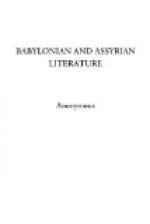TRANSLATION OF AN UNEDITED FRAGMENT
Five-sixths of an artaba[1] of corn sows an arura, a field situated on the Euphrates.
....adjoining ... wide ... adjoining ... a field in great measure ... Zirbet-u-Alzu ... and for the days to come he has given ... this table ... sin-idin ... son of Tuklat-habal-Marduk, Governor of the town of Nisin. Bani-Marduk, son of Tuklat ... Malik-kilim, son of Tuklat ... Chief of ... An-sali ... son of Zab-zib-malik ... Malik-habal-idin, of the town of Balaki ... Chief of Sin-idin-habal ... May he cause him to perish ... and his offering.[2]
[Footnote 1: The artaba was 3 epha, 18 hins; the mentioned quantity of 15 hins necessary to seed this very fertile field is only 79 pints.]
[Footnote 2: Dr. Oppert copied this text twenty years ago; he does not know whether since that time any other piece of the stone has been discovered.]
GREAT INSCRIPTION IN THE PALACE OF KHORSABAD
TRANSLATED BY DR. JULIUS OPPERT
The document of which I publish a translation has been copied with admirable precision by M. Botta in his “Monuments de Ninive” There are four specimens of this same text in the Assyrian palace, which bear the title of Inscriptions of the Halls, Nos. iv, vii, viii, and x.
There is another historical document in the palace of Khorsabad containing more minute particulars, and classed in a chronological order, which I translated in my “Dur-Sar-kayan,” 1870, and in the “Records of the Past,” Vol. VII.
The several copies of this document have been united in one sole text in a work which I published in common with M. Menant in the “Journal Asiatique,” 1863.
I published my translation of the “Great Inscriptions of Khorsabad,” in the “Annales de Philosophie Chretienne,” July and August, 1862, tom. V (New Series), p. 62; then in my “Inscriptions des Sargonides,” p. 20 (1862). The same text was inserted in the work which I edited in communion with my friend M. Joachim Menant, entitled “La Grande Inscription des Salles de Khorsabad,” “Journal Asiatique,” 1863. Some passages have been since corrected by me in my “Dur-Sarkayan,” Paris, 1870, in the great work of M. Victor Place, and these corrections have been totally admitted by M. Menant in a translation which he has given in his book, “Annales des Rois d’Assyrie,” Paris, 1874, p. 180. As the reader may easily convince himself in collating it with my previous attempts, this present translation is now amended according to the exigencies of the progressing science of Assyriology, as it is now understood.
GREAT INSCRIPTION OF THE PALACE OF KHORSABAD
1 Palace of Sargon, the great King, the powerful
King,
King of the legions, King
of Assyria, Viceroy of the gods
at Babylon, King of the Sumers
and of the Accads, favorite
of the great gods.




